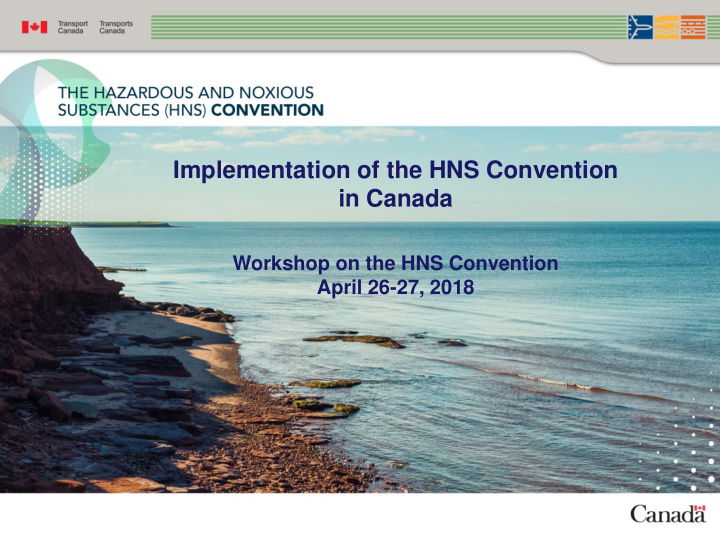



Implementation of the HNS Convention in Canada Workshop on the HNS Convention April 26-27, 2018
1996 HNS Convention Canada signed the 1996 HNS Convention in 1997, subject to ratification In 2005, a Discussion Paper was issued to consult domestic stakeholders, proposing implementation and Canadian ratification Consultations with national industries that would be required to report contributing cargo, highlighted significant difficulties, particularly with packaged/containerized HNS and LNG In 2007, the process to develop a Protocol was initiated, culminating with the adoption of the 2010 HNS Protocol
2010 HNS Protocol Consultations In 2010, Canada issued a new Discussion Paper to consult domestic stakeholders on implementation and ratification In 2011, Canada signed the 2010 HNS Protocol, subject to ratification Stakeholders generally supported Canadian ratification of the Protocol given its polluter pays approach, global coverage, sharing of the financial burden and uniform application
Domestic Legislation In 2014, amendments to the Marine Liability Act to implement and give force of law to the 2010 HNS Convention were adopted During the Parliamentary process, there was broad support for Canada adopting the Convention. Questions were focused mainly on the following issues: Does the Convention offer adequate coverage? Are the limits of liability sufficient? Does Canada need a domestic supplementary fund? Does the industry support adoption? What other states are in the process of adoption and when will it come into force?
Reporting Requirement Consultations In 2015, Canada issued a new Discussion Paper, proposing new regulations and the reporting requirements The Discussion Paper was also used to identify those industries and companies that would captured by the reporting regulations. We asked these questions to industry associations: Do you receive bulk HNS by sea? Types of substances received? Location? Do you track your receipts and would be able to easily report them? Do you have affiliates or subsidiaries that also receive bulk HNS? Do you favour an electronic reporting system? In the case of independent storage terminals, can you identify the companies on whose behalf you receive bulk HNS? Do you receive any bulk HNS that is transhipped via marine mode?
HNS Reporting Regulations In 2016, the Marine Liability and Information Return Regulations which stipulate the reporting requirements were published in the Canada Gazette. The regulations lay out the following reporting requirements: Contributing cargo imported into Canada or received from domestic carriage by sea Annual reporting thresholds of 17,000 tonnes for Non-Persistent Oil, LPG, and Other HNS, and any amount for LNG Does not create a double reporting requirement for persistent oil Addresses the issue of subsidiaries/affiliates (associated persons) Sets a reporting deadline of February 28 of the following calendar year What information is to be reporting, including information of the physical receiver, agent and principal
HNS Reporting Regulations • The reporting regulations also set out the definition of “carriage by sea” in Canada. • Given Canada’s unique geography on the Atlantic coast, the regulations draw a line where contributing cargo that either crosses the line or is received on the eastern side of the line is reported
Development of Reporting System Stakeholder feedback was received and welcomed at each stage of the process Pilot system with stakeholder’s participation Meetings and teleconferences with individual stakeholders about legislation and the reporting system Developed presentations, One-Page Information Sheet and FAQ’s to inform stakeholders Webinars 2017 – Overview of the Convention; Reporting regulations and requirement. 2018 – Focusing on the reporting mechanism (checklist of 7 key questions) and the new electronic reporting system.
Electronic Reporting System Operational since November 2017 Includes both the 1992 Fund and 2010 HNS Convention reporting requirements One employee was dedicated full-time to the Reporting System Working with technical expert building the system Developing information material for stakeholders Creating accounts for companies to report Answering questions about reporting and technical problems
Electronic Reporting System Frequently Encountered Issues : Companies that are agents/principals where there had been no previous contact – needed to contact and inform of reporting obligation Data not always accurate between Agent and Principal and need to determine which is accurate (minor differences) Use of proper substance names (synonyms) and determining if the substance is covered – use of IMO Circular No. 3144 is important for solid bulk substances Employees who work in companies with subsidiaries that do not have all reporting data and must obtain this data internally
Conclusions Consult with stakeholders frequently and consistently to get early buy-in and support Anticipate questions and issues with regards domestic issues Provide clear and concise information that allows for better comprehension by stakeholders Decide on use of IMO Guidelines for Reporting Contributing Cargo Simplify reporting mechanism or system and combine with reporting for the IOPC Funds Devote adequate internal resources to complete first report to allow for ratification/accession
Recommend
More recommend